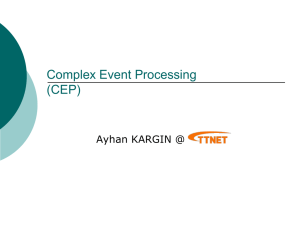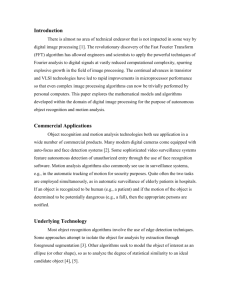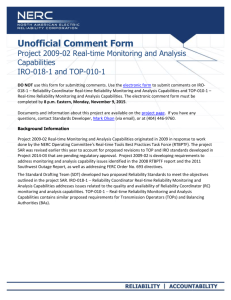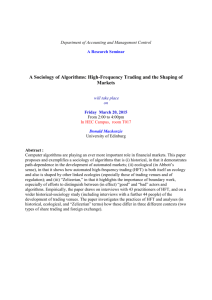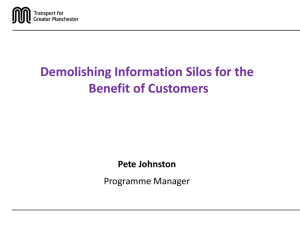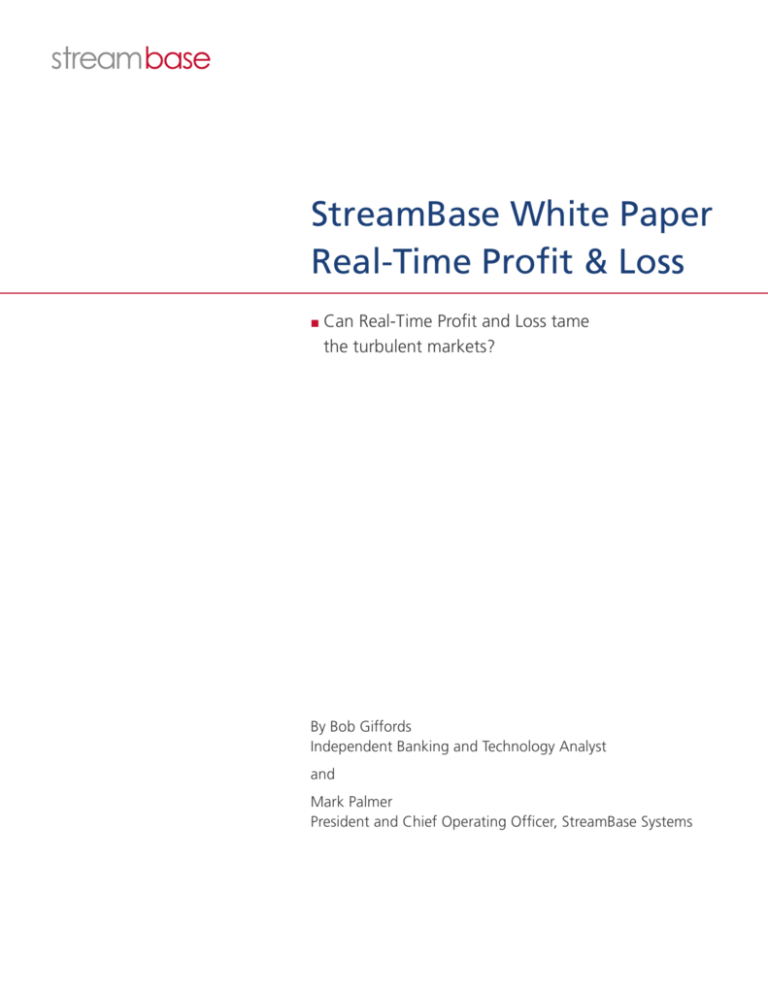
StreamBase White Paper
Real-Time Profit & Loss
n
an Real-Time Profit and Loss tame
C
the turbulent markets?
By Bob Giffords
Independent Banking and Technology Analyst
and
Mark Palmer
President and Chief Operating Officer, StreamBase Systems
Motivation for Real-Time Profit & Loss
The financial markets are accelerating: transaction volumes are up, latencies are down, complex cross
asset trading up, revenue margins down. Recently markets have seen sudden spikes in volumes, and
nervous volatility when the old rules of thumb broke down. Technology and global regulators have both
changed those rules by increasing transparency, intensifying competition, and multiplying e-commerce
relationships exponentially. Reforms such as Reg NMS in the US and MiFID in Europe have further increased
the pressure, along with Basel II and the fair value accounting rules of the new International Financial
Reporting Standards (IFRS). The IFRS require, for example, firms to mark more of their assets and liabilities
to market, while Basel II is much more explicit about risk adjusted capital reserves needed. Now, when
markets move, traders need to catch them on-the-fly to cut their losses and go with the flow to ensure
compliance with all the rules and customer mandates. The difference between just-in-time and just-toolate has just become bigger.
It was not so long ago when daily profit and loss (P&L) and risk evaluations were state of the art. In a
multicurrency world with ever more automated robotraders and instant, electronic global news, they are
now painfully slow. This impacts not only the high frequency traders or global market makers trying to
balance thousands of real-time orders and quotes against a flood of market data with awesome peaks at
tens or hundreds of thousands of messages per second.
Now the credit squeeze of 2007 has renewed the focus on costs and risk. It demonstrated that some firms
can lose billions in a single day, algorithmic trading systems can get confused in highly volatile markets,
and end of day positions may mask serious intraday exposures. So now even traditional investment
managers are keen to optimise their trading performance and track the impact of intraday movements
and fluctuating daylight exposures. If risk can change by the second, traders, investment managers and
compliance officers too need to track their P&L in real-time in order to provide a sensible framework for
judging risk as a key factor in making trading decisions during the day. Not to have at least some idea of
intraday performance is like flying blind.
Of course, some trading tools and broker algorithms already have real-time analytics. However, these all
work differently and firms typically employ multiple solutions and lack ways to integrate them into a crossplatform view of risk. In addition, the increased adoption of cross-asset trading further complicates the
real-time risk picture, and motivates the need to assess P&L across the enterprise.
So one critical question facing today’s investment managers is: Is such a firm-wide portfolio map, marked
to market in real-time, really feasible? Would it not absorb huge amounts of technology resources and
be meaningless anyway, due to insufficient or stale market data? Would not the overhead of software
maintenance inhibit innovation and the trading of new asset types like credit default or volatility swaps, so
helpful for total return funds? The answer is unequivocally yes.
Agile investment firms are in fact demonstrating that Real-Time Profit and Loss is not only feasible, but
highly lucrative as well. It opens up investment opportunities and trading styles, which might otherwise be
excluded as too risky or too demanding in resources.
New technologies like complex event processing (CEP), applied as a “white box” system for Real-Time
Profit and Loss, have turned tracking real-time market movements into a practical proposition for ordinary
firms. They can also play a key role in easing the transition to fragmented markets with their notorious
dark pools and to the complex array of order, execution and liquidity management systems to support
them.
The Market Requirements
Today’s trader execution environment involves orchestrating many different broker, market, and in-house
platforms, typically with multiple execution management (EMS) or order management systems (OMS)
dedicated to different asset classes (see figure below).
Consolidated and direct feeds from firms like Reuters, Bloomberg, Comstock and the Exchanges and ECN
platforms need to be integrated along with specialist broker and in-house feeds; and they need to be
distributed to the appropriate analytical and trading systems. Trades too need to be tracked, not just back
to orders but allocated to underlying instruments, portfolios and strategies if they are to inform decisions.
OTC transactions may not be fully automated, so data collection for Real-Time Profit and Loss will also
need to link into the appropriate work-flow processes within the firm.
Some traders are even integrating elementized news feeds as well as reference data feeds like corporate
action announcements into their pricing systems. These can be XML feeds from the news wire services to
pull out and tag key event data or market sentiment indicators from the articles themselves.
For complex instruments, pricing models mediate the data streams to value them based on market
reference prices. Indeed there are cases where multiple valuation sources are employed and these need
to be cleansed of errors or outliers, normalised and harmonised into a consistent set of prices to be used
for the P&L. Often, foreign exchange translations are needed to bring all values into the firm’s reporting
currency.
The P&L system next aggregates all the valuations and compares them to various baselines to work out
the relative gains and losses. These can be rolled up to the book, strategy or portfolio level, and the firm
may then apply alert or market signal filters.
Third Party
OMS
Venues
Market Data (e.g., Thomson Reuters,
Bloomberg, Comstock)
Equities
Messaging
Exchange Data (exchange, ECN, ATS)
Proprietary
EMS
Proprietary
Algorithms
Custom
Aggregation
Proprietary
EMS
Third Party
OMS
FX
News
Reference Data
Query
Brokers
Proprietary
EMS
Third Party
OMS
On the output side these filters might trigger intraday alerts and generate analytics
and graphical charts to enhance trader or
investment manager control. Heads of desk
may want to drill down into the detail and
understand why the values are changing.
Automated compliance auditing algorithms
can be run and compliance officers may
use this real-time view of trading activity
to monitor that regulatory and prudential
controls are enforced to satisfy demands for
intraday due diligence.
Derivatives
As traders gain confidence, the outputs
from the P&L calculation can be fed back
to algorithmic trading engines as signals
to generate automated orders using
investment strategy models. This “closed
loop” approach takes automated to a new
level of sophistication.
P&L
Risk
Compliance
Back Office
A Case Study
Firms who have deployed Real-Time Profit and Loss still consider it a competitive advantage, so the details
of their deployment are treated as trade secrets. Take the case of a large European Hedge Fund with
several billion Euros in assets. In 2007 this firm decided to go real-time for its fundamental P&L review.
Their legacy approach of tracking P&L relied on a large number of linked spreadsheets, and only managed
a single overnight run per day. In order to respond to the faster moving markets, they decided to update
their positions, P&L, risk exposures and mark-to-market valuations on instruments, portfolios, and
strategies in step with changing prices. Although the firm does not use high frequency trading strategies,
they still wanted to make quick decisions to avoid pricing on different cycles and wasting time and
resource on resolving mismatches.
“We faced two choices: one, build Real-Time Profit and Loss from scratch; the other, look for an open
platform that provided core processing and connectivity capabilities, and the ability to express our own
pricing and P&L rules on top,” explained the CTO of the firm. Following a market assessment of suitable
software tools, the firm chose the StreamBase CEP platform.
Ease of implementation and maintenance was critical for them, as it is for most hedge funds, whose
business is managing investment capital, not software engineering. CEP, for this firm, provides the
architectural underpinnings for its Real-Time Profit and Loss system, and the rapid development tools to
express the logic that calculates the firm’s P&L across systems.
In just a couple of months and with little outside assistance, the team was able to replace a large
proportion of their spreadsheets, reducing hours of daily processing down to seconds. They were soon
publishing P&L data over their enterprise service bus visible to all their operational platforms and traders.
This eliminated unnecessary reconciliations. It also gave traders, portfolio managers and back office staff
much more confidence that they now had a single version of the truth, which everyone could share.
The hedge fund had started by recalculating P&L on demand, but moved quickly to updating it on the fly
for every tick, valuing all portfolios across currencies and strategies with thousands of instruments and
hundreds of books. Now they can quickly assess the impact of changing positions on the overall portfolio
moment to moment. The StreamBase capability to access historical market and P&L information allows
them to perform root-cause P&L analysis on a tick-by-tick basis simply by changing the data source target
from the real-time streams to their in-house tick data store and replaying it through the StreamBase
engine with different analyses.
Moreover, the team is finding that the CEP technology is not only reducing operational costs of
reconciliation, but is enabling them to increase profit “dramatically” by trading out of poorly performing
positions and focusing on more promising instruments and strategies. “Intraday monitoring across all our
portfolios allows us to spot trends much more easily,” confirmed their CTO. Their current challenge is how
to leverage these P&L signals to optimise algorithmic trading strategies.
The Elements of a CEP-Based
Real-Time Profit & Loss Architecture
The basis for the hedge fund’s P&L system is StreamBase, a leading CEP platform and application
development studio. StreamBase combines connectivity, algorithms, menus, control screens, and best
practices as a solution framework for firms wanting Real-Time Profit and Loss capabilities.
CEP provides an open, “white-box” approach, as compared to the more traditional “black-box,”
packaged applications. It allows capital markets firms to leverage prefabricated components (e.g., ECN
or EMS/OMS connectivity, customizable calculators, etc.) to develop their own high speed, low latency,
application fabrics. Encouraged by their customer experience, StreamBase, in particular, now provides
Real-Time Profit and Loss application templates as pre-built, customizable software components of their
robust CEP platform.
The key elements of such a CEP-based P&L platform include:
n
Real-Time Profit and Loss Algorithms. Algorithms that compute Real-Time Profit and Loss against
streaming orders and executions — expressed in a CEP language — provide firms with a head-start in
obtaining their own customized pricing and signalling algorithms.
n
Market Data Connectivity. Built-in connectivity to market data such as Thomson Reuters and
Bloomberg accelerates installation and integration with a key source of input to the P&L engine.
OMS and EMS Connectivity. Trading actions are often signalled by Real-Time Profit and Loss
movements, so electronic connectivity between the CEP platform and the firm’s EMS and OMS systems
can help turn signals into trading action as well as capture trade data.
n
Middleware and Database Connectivity. Connectivity to industry-standard relational databases
(Oracle, Sybase) provides access to reference data, and allows baseline P&L valuations to be stored and
accessed in order to update portfolio-level P&L valuations on the fly. Access to tick data stores, such as
from Kx Systems and Vhayu, allows the Real-Time Profit and Loss algorithms to access historical data in
real-time.
n
Visualization Tools. Real-Time Profit and Loss engines are often integrated with existing graphical
user interface frameworks, including Microsoft .NET (WPF), browser-based HTML, Java and other thirdparty user interface technologies. Visualization templates show a real-time view of the P&L in both tabular
and graphical formats with green and red numbers to highlight up or down ticks, and capabilities for drilldown analysis and roll-up summaries by book, portfolio and strategy.
n
Graphical Application Design Tools. StreamBase Studio is an example of a CEP development tool
designed for both quants and software developers to graphically compose, back-test, deploy, and evolve
P&L algorithms. Firms can start with the built-in P&L algorithms and then add algorithms for different
currencies, asset classes, roll ups, and netting options. They can change valuation algorithms with multiple
rule sets for different trading strategies, and change alert and threshold filters as well. Indeed any of the
P&L rules can be amended and maintained by the investment firm.
n
n
High-Performance CEP Engine. A CEP run-time engine, which can be deployed across distributed
server grids, provides a powerful execution platform for Real-Time Profit and Loss logic, ensuring a
reliable, high-speed, multi-threaded platform for deployment even in the most demanding high-frequency
environments.
Market Data
(Reuters, Bloomberg, etc.)
Market Venue
Pricing
P&L
Signaling
Open-Source Algorithms
Real Time P&L
User Interface
Visualization
(ECN, ATS, DMA)
Fault Tolerance
StreamBase Studio
Reference Data
Management
Backtesting
Adapter Toolkit
StreamBase CEP
Engine
Debugging, Profiling
Database
(RDBMS)
(Reuters, Bloomberg, etc.)
(Propriety systems, middleware)
Connectivity
CEP Platform
Custom
Code
(Java, C++, Pricing
Analysis)
Development
This open, standards-based platform allows a firm to connect to their portfolio definitions, update them
from streaming data from multiple venues, execution flows, and reference data, re-calculate gains and
losses on the fly with respect to previously stored baseline valuations, apply multiple threshold filters for
signal generation, and output to a range of downstream systems.
Who Needs to Know?
Investment banks, hedge funds, asset managers, and retail brokers can all leverage Real-Time Profit and
Loss. Early adopters can reap significant competitive benefits especially in volatile markets.
Investment banks often have to deal with scale - organizational and global scale. Flow traders may focus
on transaction cost analysis (TCA) metrics, while market makers and proprietary desks may already have
Real-Time Profit and Loss embedded in their trading algorithms. However, the rise of cross asset class
and basket trading from asset managers, latency arbitrage from the hedge funds, and best execution
regulation for flow traders across fragmented markets can increase the pressure on sell-side firms to
consider seriously cross-channel, Real-Time Profit and Loss tools. Where there are options to share liquidity
or to internalise a trade and take the risk onto the firm’s own books, Real-Time Profit and Loss and what-if
scenarios will become essential.
Hedge funds too have been early adopters of Real-Time Profit and Loss for use in high frequency trading
strategies that ensure an algorithm’s statistical arbitrage comes out in profit. Additionally, as the case study
reveals, Real-Time Profit and Loss can also be used as a decision support tool for less quantitative trading
styles, giving traders an effective intraday view of their positions.
Asset managers, who traditionally take a longer view and do fewer trades, may be driven more by
concerns around risk and market volatility than increasing alpha. However, growing competition for alpha
and the trend towards more cross asset class trading including 130/30 funds, total return funds, liability
driven investment, and other hedging strategies may well motivate a more serious consideration of
intraday P&L in the asset management space.
Some retail brokers already offer Real-Time Profit and Loss tools as they compete for mind share among
the day traders and hands-on high net worth individuals. For them, CEP-enabled Real-Time Profit and
Loss offers a more flexible, robust, and rapid alternative to custom software development. The ability to
personalize calculations in real-time by extending algorithms enables them to provide more features more
quickly than their competitors, and therefore attract and retain more customers and flow.
Moving Forward
Continued Fragmentation and Complexity Drive Innovation and Change
There is a growing recognition that the need to capture and leverage the intellectual property embedded
in the trading desk is the new basis for competition in the capital markets. Algorithmic trading, smart
order routing, and alternative investment strategies continue to rise in stature. Yet despite some
consolidation, it is likely that the capital markets landscape will continue to fragment and become more
complex. Volumes and volatility will inevitably grow as the number of e-commerce relationships explodes.
As a result, the need to consolidate views across trading platforms, books, portfolios and investment
strategies can only increase. This complex environment is complemented by the never-ending series of
mergers, acquisitions, spin-offs, and new market initiatives that ensure a steady stream of fragmented
systems that will need aggregation.
Flexible services like Real-Time Profit and Loss therefore appear to be an ideal response to these
challenges. They help to integrate systems, encourage innovation, and facilitate opportunistic mergers and
acquisitions, without major technology consolidation or development programs. In brief, they provide agile
yet tight control during turbulent markets.
About Bob Giffords
Bob Giffords is an independent banking technology analyst based in the UK, who carries out research on
the global evolution of the global capital markets. Following a long career in systems development and
consulting to the finance sector, he was CTO for a leading bond trading platform in Europe. He is now
a frequent speaker at securities industry conferences and writes for various industry journals including The
Trade, Waters, Dealing with Technology, Swift Dialogue and Financial World. He can be reached at
bob.giffords@btinternet.com.
About Mark Palmer
Mark Palmer is President and Chief Operating Officer at StreamBase Systems, Inc. He leads worldwide
sales, marketing and professional services teams. Mark is a long time advocate of the growing role of CEP
and has published more than 30 articles on the application of CEP to real world problems and spoken
at numerous industry events. In 2005, he won an InfoWorld Innovator award and was named to the
InfoWorld Media Group’s Innovators Hall of Fame for his work in event processing.
About StreamBase
StreamBase Systems, Inc, a leader in high-performance Complex Event Processing (CEP), provides
software for rapidly building systems that analyze and act on real-time streaming data for instantaneous
decision-making. StreamBase’s Event Processing Platform(tm) combines a rapid application development
environment, an ultra low-latency high-throughput event server, and the broadest connectivity to real-time
and historical data and leading EMS/OMS software platforms. Six of the top ten Wall Street investment
banks and three of the top five hedge funds use StreamBase to power mission-critical applications
to increase revenue, lower costs, and reduce risk. It is also used by government agencies for highly
specialized intelligence work. The company is headquartered in Lexington, Massachusetts with European
offices in London. For more information, visit www.streambase.com.
Corporate Headquarters
181 Spring Street
Lexington, MA 02421
+1 (866) 787-6227
New York Office
845 Third Avenue, 6th Floor
New York, NY 10022
+1 (866) 787-6227
Virginia Office
11921 Freedom Drive, Suite 550
Reston, VA 20190
+1 (703) 608-6958
European Headquarters
60 Cannon Street
London, EC4N 6NP
+44 (0) 20 7002 1095
www.streambase.com
2008 © StreamBase Systems, Inc. All rights reserved. StreamBase, StreamBase Studio, and When Now Means Right Now are trademarks of StreamBase Systems, Inc.
All other trademarks are the property of their respective owners.



